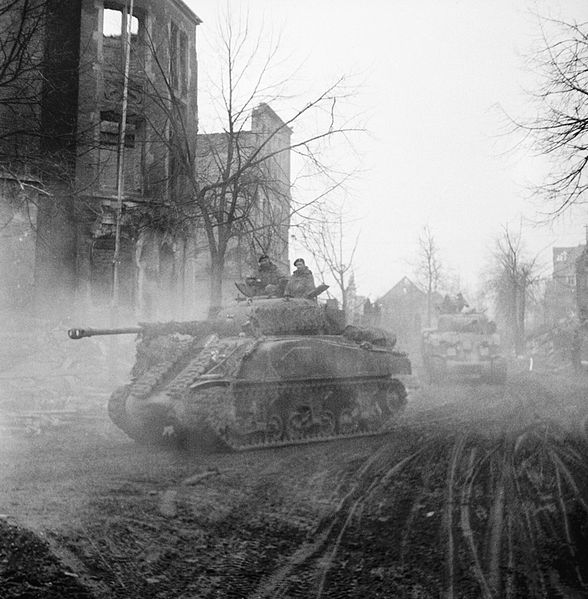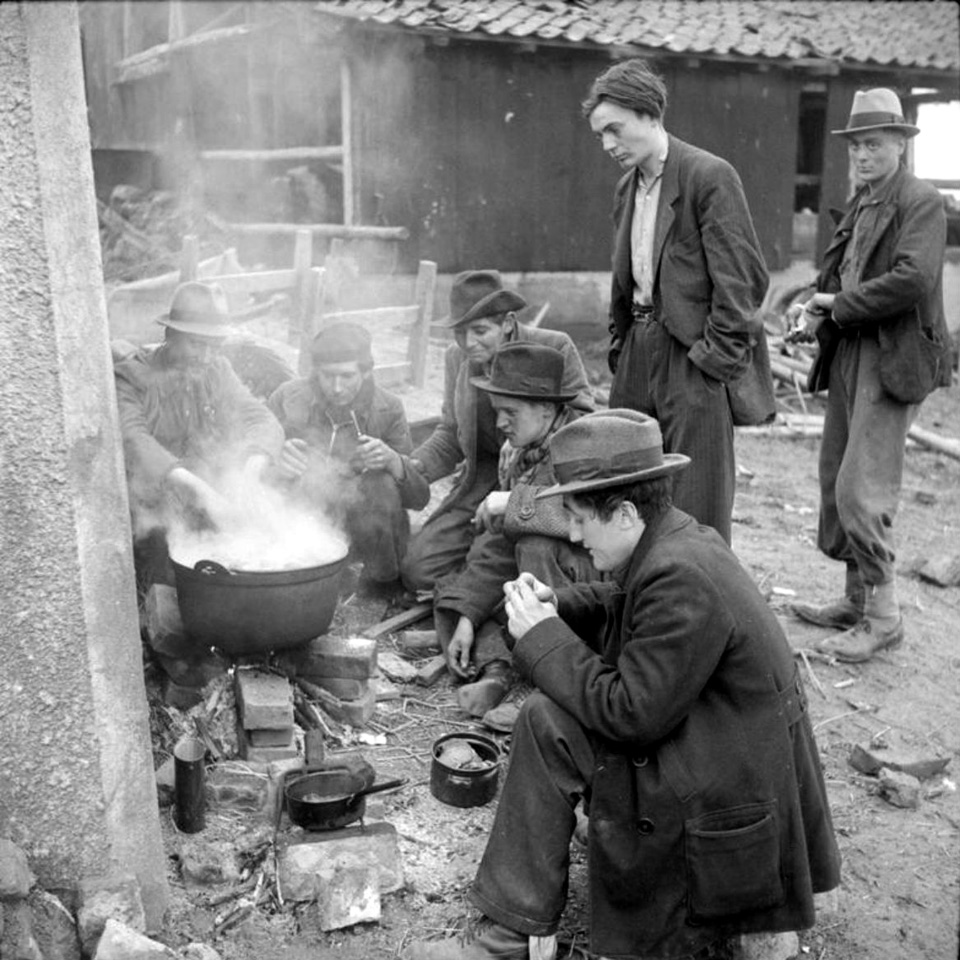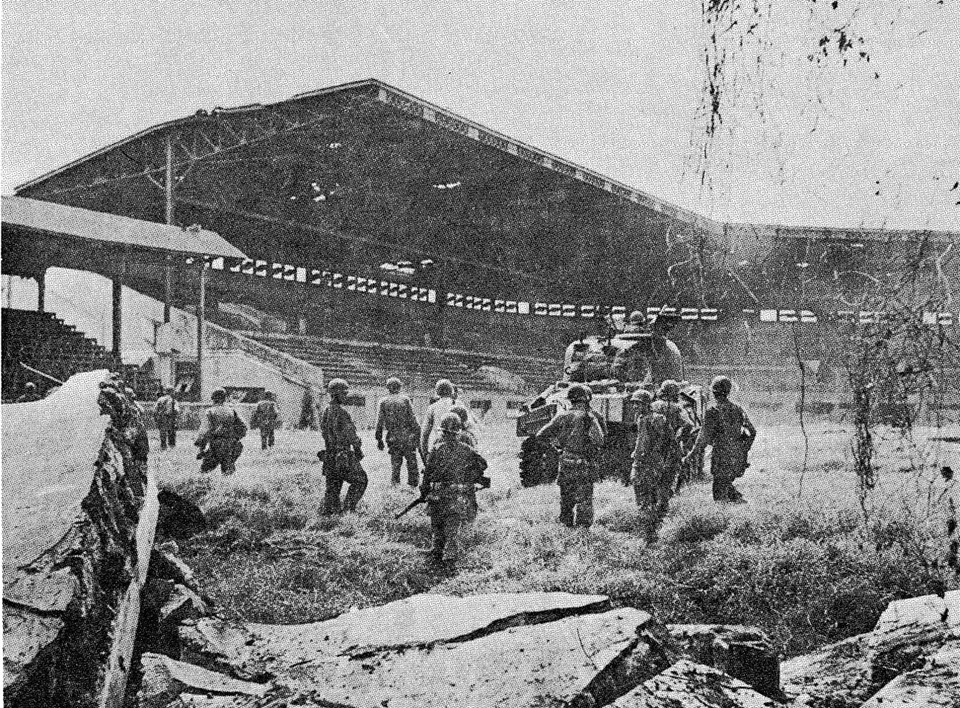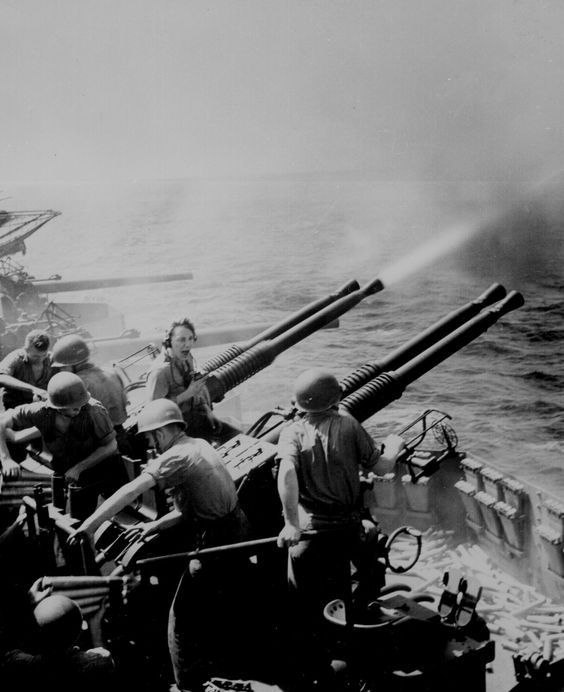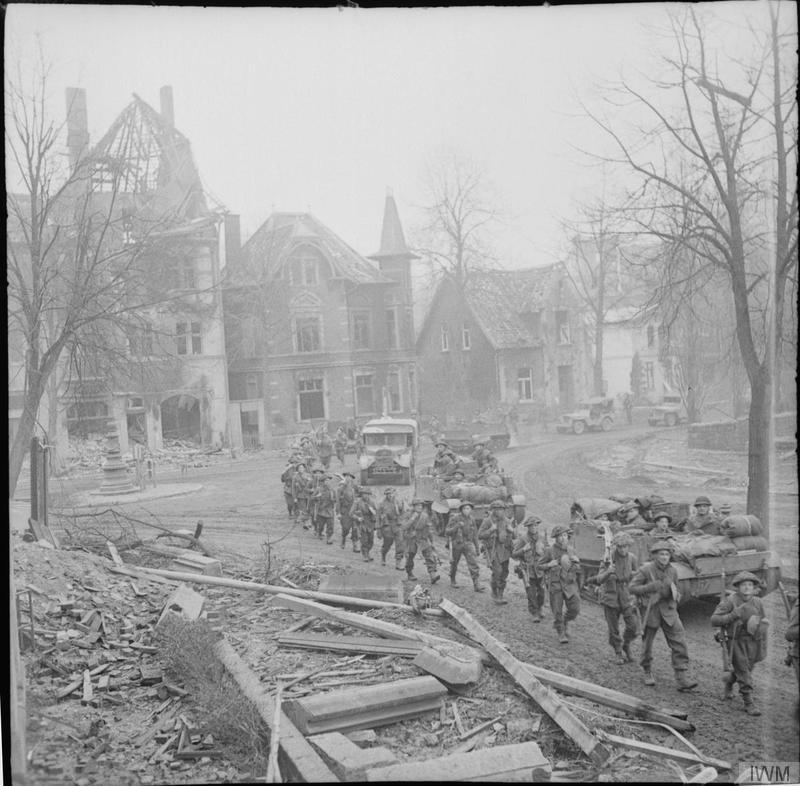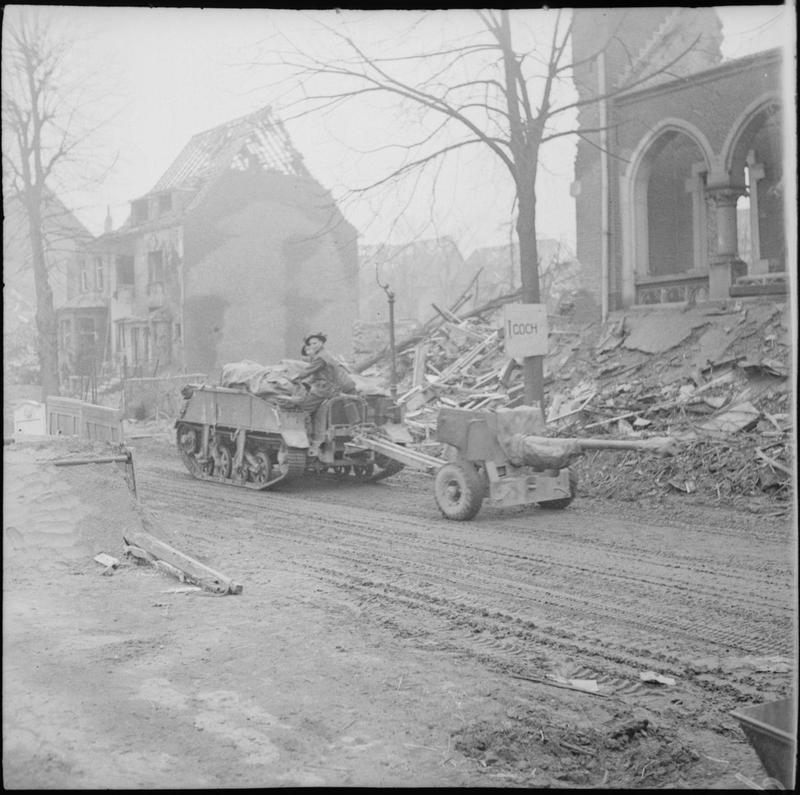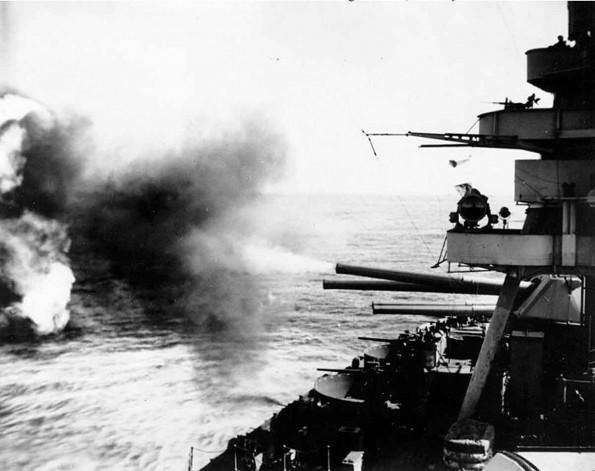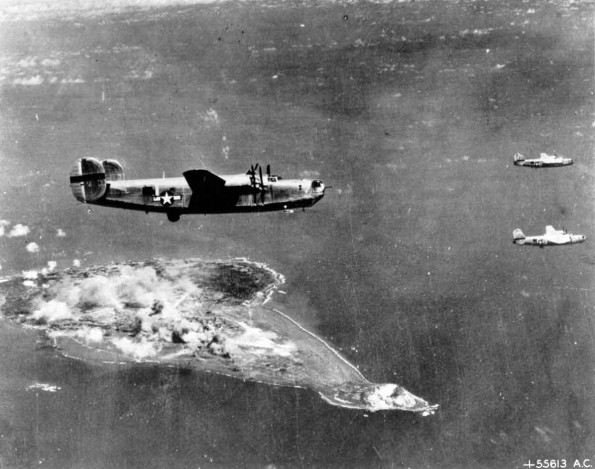Air Operations, CBI
BURMA- 12 10th Air Force B-25s attack troops, motor vehicles, and stores while sweeping roads south of Lashio and between Hsenwi and Loile.
- Nearly 160 10th Air Force fighter-bombers attack troops, artillery positions, occupied towns, transportation targets, and targets of opportunity at 18 locations.
- 31 P-47s support Allied ground forces in the Myitson area.
- 33 14th Air Force fighter-bombers attack airfields and road, rail, and river traffic across China and northern French Indochina.
Air Operations, East Indies
5th and 307th Heavy Bomb Group B-24s attack the Kendari airfield on Celebes.
[Air Operations, Europe
RAF BOMBER COMMANDDaylight Ops:
- 100 Lancasters of No. 3 Group and 1 Mosquito of No. 8 Group attack the town of Wesel on the Rhine, near the fighting area. The raid takes place in clear conditions and 'the town and the railway were seen to be smothered in bomb bursts'.
- There are no losses.
GERMANY:
- 194 1st Air Division B-17s attack oil-industry targets at Dortmund, Minster Stein, and Nordstern.
- 268 2nd Air Division B-24s attack marshalling yards at Osnabruck and Rheine.
- 46 2nd Air Division B-24s attack a marshalling yard at Munster.
- 208 3rd Air Division B-17s attack a marshalling yard at Hamm.
- 63 3rd Air Division B-17s attack a rail bridge at Wesel.
- 102 heavy bombers attack various targets of opportunity.
- 8 heavy bombers are lost.
GERMANY:
- More than 300 9th Air Division bombers attack a communications center, a rail bridge, an ordnance depot, a jet-engine factory, and targets of opportunity, mostly in the Ruhr River valley.
- 9th Air Force fighters and fighter-bombers attack bridges and rail lines.
ITALY:
- 12th Air Force B-25s are grounded by weather, but XXII TAC P-47s attack rail lines and ammo and fuel dumps.
GERMANY:
- 263 15th Air Force B-24s attack the Me-262 factory at Regensburg, where they destroy an estimated 20 jet interceptors on the ground and damage the manufacturing facility.
- Other B-24s attack the nearby jet airdrome at Neubiberg.
- Approximately 450 15th Air Force B-17s and B-24s dispatched against a variety of targets in central and southern Europe are forced to return to their bases because of bad weather.
Air Operations, Formosa
V Fighter Command fighter-bombers attack rail and road targets across southern Formosa.
[Air Operations, Japan
- Despite unfavorable weather conditions, Task Force 58 carrier aircraft launched from approximately 125 miles southeast of Tokyo and only 60 miles from the Honshu coast open an intense air and naval interdiction offensive in support of the impending invasion of Iwo Jima in the nearby Volcano Islands. In addition to Japanese airfields and ports, the carrier bombers and fighter-bombers also attack Tokyo-area aircraft-industry targets that 20th Air Force B-29s have not been able to demolish. Task Force 58 loses 60 aircraft in combat and operational accidents. Among the lost airmen in Cdr Philip H. Torrey, Jr., the Fleet Carrier Air Group 9 commander.
- USN carrier-based F6Fs and F4Us down 270 Japanese aircraft over the Tokyo area between 0800 and 1710 hours, and USMC carrier-based F4Us down 14 Japanese bombers, fighters, and reconnaissance aircraft between 0830 and 1400 hours.
- During the night, US Navy night fighters suppress Japanese efforts to mount attacks against Task Force 58, but bad weather prevents night TBMs from locating and attacking Japanese shipping, as planned.
Air Operations, Philippines
- Following an intense final air and naval bombardment that includes effective sorties by 24 FEAF B-24s, 11 V Bomber Command B-25s, and 31 A-20s, and in conjunction with an amphibious assault by US 6th Army ground troops, 51 317th Troop Carrier Group C-47s drop 1,021 paratroopers of the US 503rd Parachute Infantry Regiment and 151 supply bundles on Corregidor Island beginning at 0830 hours. As the paratroopers land, 70 A-20s bomb and strafe predetermined targets on Corregidor and nearby Caballo Island. During the afternoon, 50 317th Troop Carrier Group drop 978 paratroopers and 159 supply bundles on Corregidor.
- V Bomber Command B-25s support US 6th Army ground forces in the Mariveles area and attack the Camalaniugan airfield on Baguio and Santa Fe.
- A-20s and V Fighter Command fighter-bombers attack Caballo Island.
- P-38s attack the Likanan and Matina airfields on Mindanao.
Air Operations, Volcano Islands
Despite poor weather and rough seas, US surface warships, aircraft from Task Group 52.2, and 42 VII Bomber Command B-24s open an intense pre-invasion bombardment at Iwo Jima and Chichi Jima, but the B-24s are recalled due to dense cloud cover over the target. Several planned strikes by escort carrier fighters and TBMs are also thwarted by the miserable weather.
[Battle of the Atlantic
Escort Group 9 is escorting Convoy WN-74 into Moray Firth when the British frigate St John reports an asdic contact. It is determined that the U-boat, U-309, is hiding on the bottom. After several attacks with depth charges and Hedgehogs, a mass of wreckage appears on the surface.
| Class | Type VIIC |
| CO | Oberleutnant zur See Herbert Loder |
| Location | North Sea, Moray Firth |
| Cause | Depth charge |
| Casualties | 47 |
| Survivors | None |
Burma
In the British XV Corps sector, a brigade of the 25th Indian Div lands on the Arakan coast near Ru-ywa, west of An; with the 82nd East African Div coming down from the north, they will cut the Japanese off from their withdrawal route to Prome. Hard fighting continues between the Japanese and the 20th Indian Div, British XXXIII Corps, on the bridgehead over the Irrawaddy in the Myinmu-Allagappa area.
[Diplomatic Relations
Venezuela declares war on Germany and Japan.
[Eastern Front
German headquarters admits for the first time that there are 'gangs' trying with Russian help to penetrate from Slovakia into the Protectorate of Bohemia-Moravia.
The German 8th Army is engaged with the 2nd Ukraine Front in Hungary.
Russian forces complete the encirclement of Breslau. The 1st Belorussian Front takes Sagan (Zagan), from which the Germans manage to withdraw the Hermann Göring Corps, which had been almost completely surrounded.[MORE]
[Italy
Headquarters, US 5th Army, issues directives for limited attacks by the divisions of the IV Corps, to begin on the 20th, to reinforce the positions west of Highway 64.
[Iwo Jima
The preliminary bombardment for the American landings begins in earnest. Adm Bertram J. Rodgers leads the 6 battleships, 5 cruisers and 16 destroyers of TF 54 in the operation and the 10 escort carriers of TF 52 also make attacks including many with the new napalm bombs. On the 16th the bombardment is comparatively ineffective because of bad weather and poor observation, but on the 17th and 18th more is achieved. On the 17th there are also bombing raids by B-24 bombers. The battleship Tennessee is hit on the 17th, and a cruiser and several of the smaller ships charged with minesweeping and obstacle clearing duties are also damaged.
[Japan
Over the next 2 days there are attacks by the 12 fleet carriers and 4 light carriers of TF 58, now returned to Spruance's command as part of 5th Fleet, against Tokyo alone on the 16th and against Tokyo and Yokohama on the 17th. Over 2,700 sorties are flown and 88 American planes and twice as many Japanese are shot down. The carriers are escorted by 8 battleships, 15 cruisers and 83 destroyers as well as many other support ships and their escorts. The force moves off toward Iwo Jima when the strikes have been completed.
[Kuriles
An American cruiser and destroyer force shells Kuraba Zaki.
[Mariana Islands
Task Force 52, transporting the expeditionary force to Iwo Jima, sails from Saipan.
[Pacific
- The US submarine Barbel (SS-316) is reported as presumed lost in the Pacific Ocean area.
- Two US destroyers, Ingraham (DD-694) and Barton (DD-722) are damage in a collision in the Iwo Jima area.
- The US submarine chaser PC-1119 is damaged by coastal gunfire in Luzon area of the Philippine Islands area.
- The US support landing craft LCS(L)-7 is sunk by Japanese assault demolition boats off the entrance to Mariveles harbor.
- The US submarine Sennet (SS-408) sinks the Japanese minelayer Naryu southeast of Honshu, but is damaged by depth bombs from enemy aircraft.
Philippines
On Luzon fighting continues in Manila. In the XI Corps sector, after a powerful preparation by aircraft and naval gunfire, the US 5th Air Force drops a parachute regiment on Corregidor, while a battalion of the 34th Inf, 24th Div, lands on the island from Mariveles. The operation takes place between 8:30a.m. and 10:30a.m. The Japanese, taken by surprise, are unable to prevent the Americans from establishing a bridgehead. The attacking troops land successfully enough but a bitter struggle soon develops among the tunnels and gun emplacements of the island. The US troops are quickly reinforced. Since the battle for Luzon began 3,200 tons of bombs have been dropped on Corregidor.
[Western Front
Further advance by the British XXX Corps, Canadian 1st Army, which takes Asperberg, Asperden and Afferden.
Limited activity in the sector of the XII Corps, US 3rd Army, which concentrates on further strengthening of its positions beyond the Siegfried Line, and in the XX Corps sector, where units of the 26th Div continue with the consolidation of the Saarlautern bridgehead.
[Images from February 16, 1945
|
|
|
|
|
|
|
|
